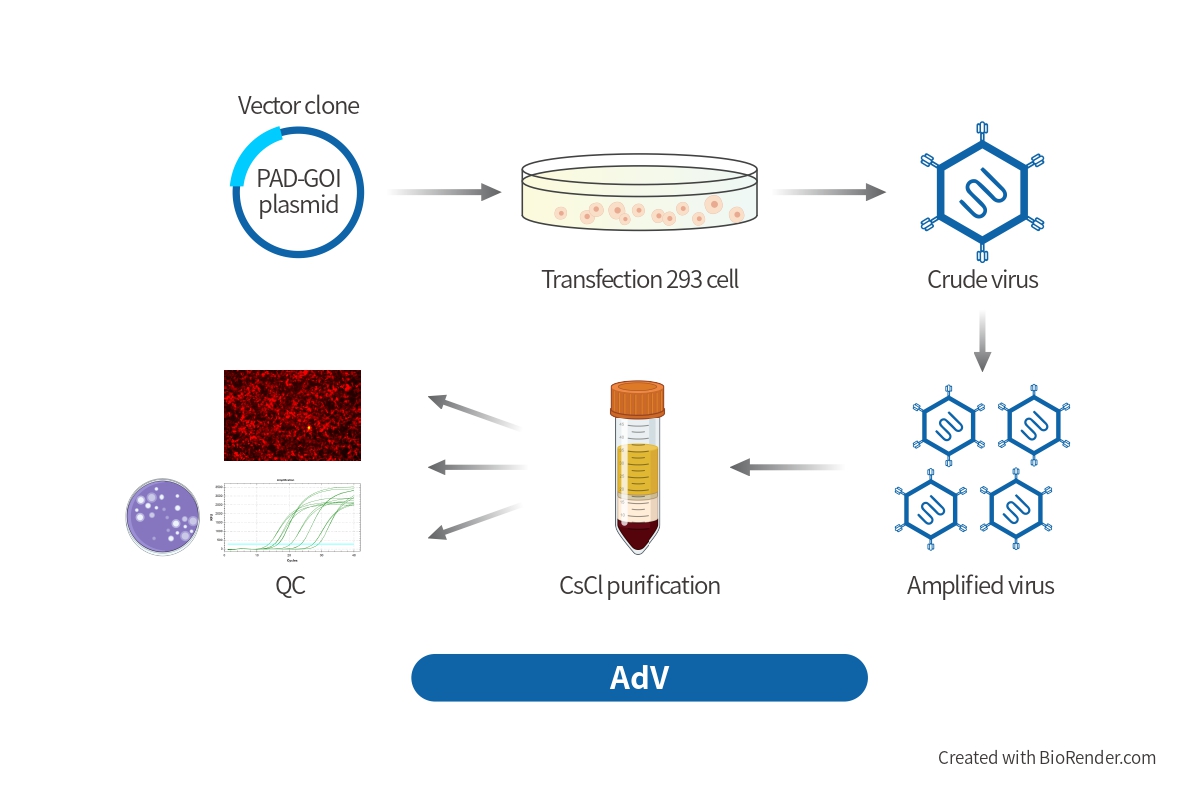Custom Lentivirus Vector Design
We also provide cloning services to allow you to fully customize your order at a reasonable cost and with a quick turnaround time, include over express any genes (wildtype, mutant or synthetic) or to silence/knock-down/knock-out/knock-in any genes. Please contact us with your project details and our team will get in touch as soon as possible with annestimated price and projected turnaround time. You can also visit our Molecular Cloning page for more information. If you already have the ORF in plasmids, you just need to send the min- plasmid to us, then we will clone in LV vector and package it.
Recombinant Lentivirus packaging services
BrainVTA provides the custom-made Lentivirus with the titer is more than 1 x 10^8TU/mL.We use third-generation lentivirus packaging, transfer plasmid carrying the gene of interest (GOI) is co-transfected with our proprietary VSV-G envelope plasmid and packaging plasmids encoding Gag/Pol and Rev into HEK293T cells. After 48 hours of incubation, the supernatant is collected and centrifuged,lentiviral particles were obtained after concentration. All customized services undergo stringent quality control to ensure that you obtain reliable, reproducible highly purified and high-titered viral particles every time you order.

| Application | Volume | Price | Timeline |
|---|---|---|---|
| in vitro, ≥5e+8 TU/ml |
500ul | $750.00 | 2-3 weeks |
| 1ml | $1220.00 | 2-3 weeks | |
| Other scale | Inquiry | ||
| in vitro & in vivo, >2e+9 TU/ml |
500ul | $1599.00 | 2-3 weeks |
| 1ml | $2399.00 | 2-3 weeks | |
| Other scale | Inquiry | ||
What should I do when I need the service
- Just submit your needs to us by clicking the Online Inquiry button or email us at sales@brainvta.com and our experienced scientists will design your vector for free.
- Or, for any customer who decides to take use of viruses as nucleotide sequence delivery tools, our scientists will work with you step-by-step from design of study to viral manufacturing to meet your purpose.
If you would like to establish a cell line, please specify when you request a quote. Please visit our cell line service for more information!
LV packaging Services FAQs
-
1. Is recombinant lentivirus safe to use?
Lentivirus particles provided by BrainVTA are pseudoviruses whose toxic genes have been removed and replaced by exogenous target genes. They are capable of infection but not replication, so they are safe to use. Nevertheless, all work with lentiviruses should be performed in a BSL-2.
-
2. What is the difference between 2nd and 3rd generation lentiviral systems?
Briefly, 3rd generation lentiviral systems are considered safer than second generation systems. The 3rd generation lentiviral systems require transfection with four separate vectors in order to create functional lentiviral particles.
-
3. .What's the cloning capacity for rLV?
rLV has a packaging capacity of 8.5Kb. After removing the promoter and the resistance/fluorescence genes, the lentivirus can contain no more than 4KB of exogenous gene, and the longer the exogenous gene, the more difficult it is to obtain a higher titer.
-
4. What is the recommended storage temperature?
rLV should be stored at -80℃. However if the virus is repeated freeze-and-thaw, it will cause significant decrease of titer
-
5. What are the precautions for lentivirus dilution and use?
It can be diluted with PBS or serum-free medium, mixed and divided, and it is recommended to use up the diluted sample at one time. The lentivirus should be thawed in 37℃water after being taken out at -80°C with the volume is more than 1mL, while it can be thawed at room temperature if the volume is 100-1ml. Bur if the virus is less than 100ul, it should be thawed in 4°C ice.
-
6. When does gene expression peak appearing after lentivirus infection?
Lentivirus expression is relatively slow. Most cells have the expression peak of the fluorescence or target gene within 72 to 96 hours after infection, but for slow-growing cells, the time may be longer.
-
7. Why does the overexpressed lentiviral vector have darker fluorescent than the control?
The vector capacity of the virus is limited, if the inserted gene is too large, the expression of genes will be affected. If this happens, the amount of virus infection can be appropriately increased.
References
- Dang T, Duan W Y, Yu B, et al. Autism-associated Dyrk1a truncation mutants impair neuronal dendritic and spine growth and interfere with postnatal cortical development[J]. Molecular Psychiatry, 2017.
- Cetin, A. and E.M. Callaway, Optical control of retrogradely infected neurons using drug-regulated "TLoop" lentiviral vectors. J Neurophysiol, 2014. 111(10): p. 2150-9.
- Cetin, A. and E.M. Callaway, Optical control of retrogradely infected neurons using drug-regulated "TLoop" lentiviral vectors. J Neurophysiol, 2014. 111(10): p. 2150-9.
- Parr-Brownlie, L.C., et al., Lentiviral vectors as tools to understand central nervous system biology in mammalian model organisms. Front Mol Neurosci, 2015. 8: p. 14.
- Parr-Brownlie, Louise C., et al. "Lentiviral vectors as tools to understand central nervous system biology in mammalian model organisms." Frontiers in Molecular Neuroscience. 8(2015).
- De Juan-Sanz J , Holt G T , Schreiter E R , et al. Axonal Endoplasmic Reticulum Ca 2+, Content Controls Release Probability in CNS Nerve Terminals[J]. Neuron, 2017, 93(4):867-881.e6.
- Sakurai K , Zhao S , Takatoh J , et al. Capturing and Manipulating Activated Neuronal Ensembles with CANE Delineates a Hypothalamic Social-Fear Circuit[J]. Neuron, 2016:S0896627316307164
- Yao X H , Wang M , He X N , et al. Electrical coupling regulates layer 1 interneuron microcircuit formation in the neocortex[J]. Nature Communications, 2016, 7:12229.







